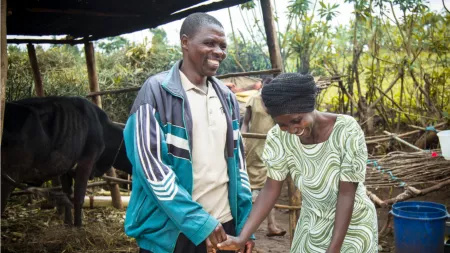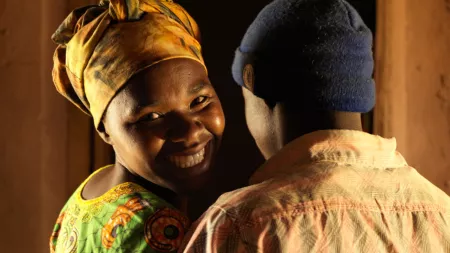If women and girls are more hungry than men and boys, the solution is more food, right?
Actually, no. Gender inequality means men and women experience food insecurity in different ways. One of the additional challenges faced by women is increased risks of gender-based violence (GBV).
25 November marked the International Day for the Elimination of Violence Against Women and we are in the midst of 16 Days of Activism Against GBV. There is no better time to underscore why addressing GBV is so critical for those facing hunger. Put simply, if we fail to consider the context-specific challenges women and girls are confronted with, at best they will continue to be hungrier than men and boys; at worst they can be at increased risk of harm.
"From cooperation with my husband, there is better management of our resources, and we are no longer in the lowest category of poverty ranking. We sell our harvest to be able to afford other foods like rice,"Clementine, Indashyikirwa project participant.
The good news is that investing in deep engagement on gender equality to address GBV doesn’t just make women safer—it helps them access food, helps their families eat more, and can even increase their food production overall.
CARE reviewed recent reports, Rapid Gender Analyses and project evaluations to understand how GBV and food insecurity are linked—and highlight what we’ve learned from our programs to ensure positive impacts for women facing the current challenges of the global food crisis.
What do we know?
- Food insecurity affects GBV in many ways: The compounding impacts of climate change, conflict, resource scarcity, increased commodity costs and deepening food insecurity all contribute to women and girls being hungry; these stressors also amplify GBV risks. The social norms and power dynamics which limit women’s voice and role within the household affect their access to food AND make them vulnerable to violence.
- GBV can prevent women and girls from accessing food: In crisis situations, the risk of being sexually harassed, assaulted, or even coerced into exchanging sex for food when going to emergency food distributions can prevent women and girls from accessing food. In situations where women and girls are already vulnerable, they may eat less to avoid intimate partner violence (IPV)—women reported this in Bangladesh and India.
- Child, early and forced marriage is increasing: In Somalia, 1 in 3 girls reported parental pressure to marry early was their biggest concern. In Afghanistan, nearly 1 in 8 households surveyed indicated having to marry one of their girls under 18 due to the food crisis.
- Domestic and intimate partner violence is increasing: In the Central African Republic over the last two years, reports of intimate partner violence have increased in the lean season, during drought periods and in areas where food insecurity is higher. In Somalia, women reporting domestic violence as their primary concern went from 1 in 4 in 2021 to 1 in 3 in 2022.
- This is a problem in development settings as much as it’s a humanitarian issue: Women in Bangladesh reported a 21% increase in violence at household level as a result of price hikes. In Rwanda, food scarcity is intensifying existing violence in homes.

What have we learned?
- Social norms approaches can reduce the gender food gap: In Bangladesh, focusing on household power dynamics reduced the domestic violence young brides experienced AND led to them eating with their husbands as equals. In Ethiopia, social norms approaches reduced girls’ vulnerability to child marriage AND addressed cultural taboos which prevented them from eating certain nutritious foods.
- Social norms approaches can also reduce child marriage: In Ethiopia, strong social norms integration helped achieve a 44% reduction in child marriage for the Abdiboru project. In Benin’s Projeunes project, rates more than halved. In Bangladesh, the Tipping Point initiative reduced child marriage by 63%.
- Addressing IPV helps families eat more: In Rwanda, engaging couples in dialogue on power and gender through the Indashyikirwa project led to participants reporting increases in their odds of having cash income and household food security, accompanied by overall reductions in household scores for hunger.
- Improving household relations makes families more resilient: Four years after the Indashyikirwa project in Rwanda ended, increased gender equality within families as a result of GBV prevention activities is helping couples deal with crises more proactively and equally.
- Improving gender equality improves food production: In Burundi, addressing gender and social norms, building women’s solidarity, and engaging men on gender equality in the Win Win project led to households more than doubling their rice production. At the same time, the proportion of men engaged in the project who believe domestic violence is never acceptable also doubled.
Want to learn more?
Check out Gender-Based Violence & Food Insecurity: What we know and why gender equality is the answer for further detail on the links between GBV and food insecurity, and learn more about the specific experiences of farmers in Rwanda in this food brief.
